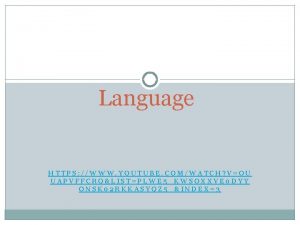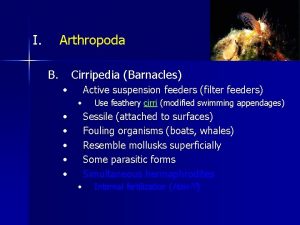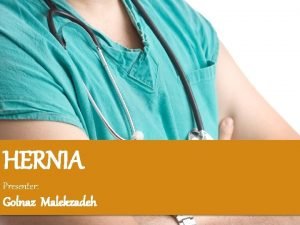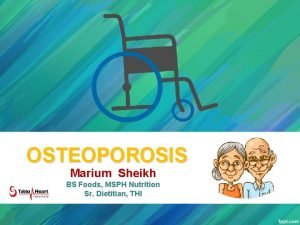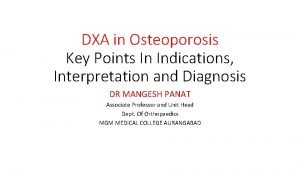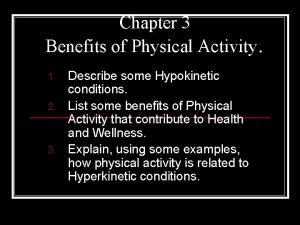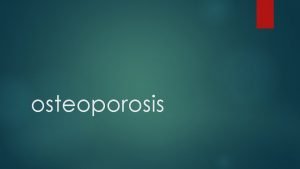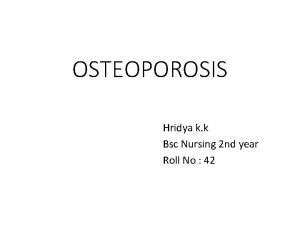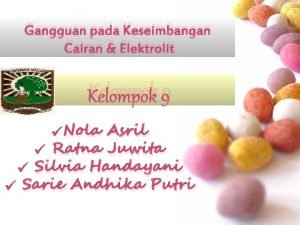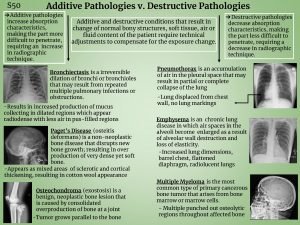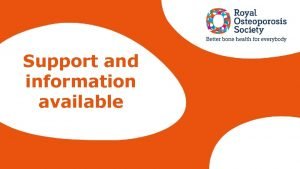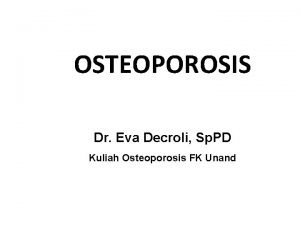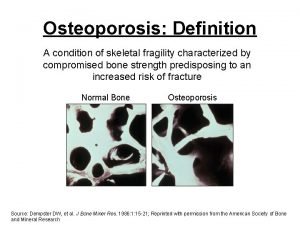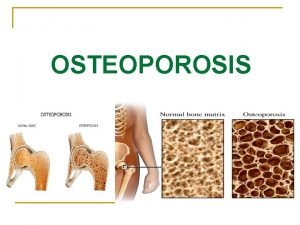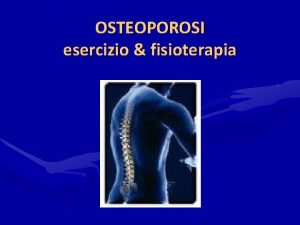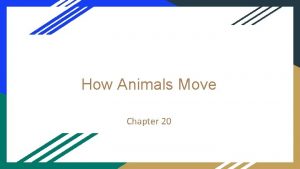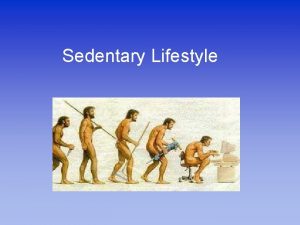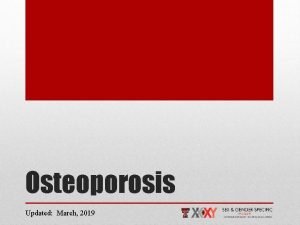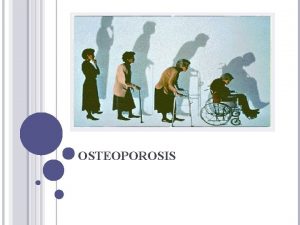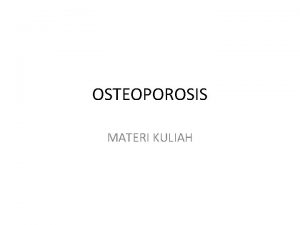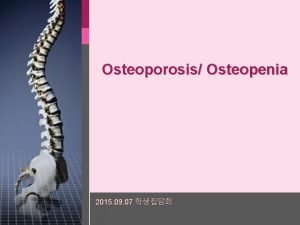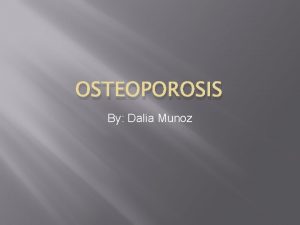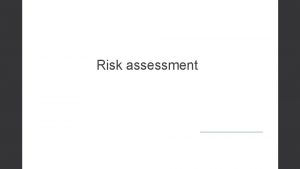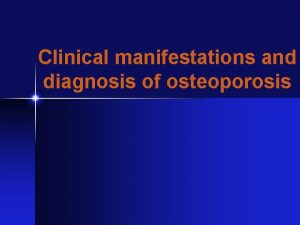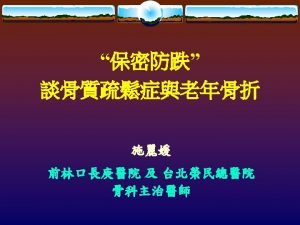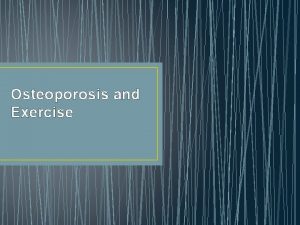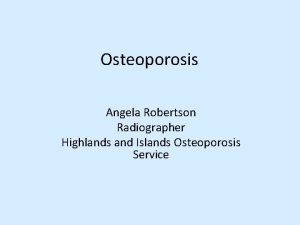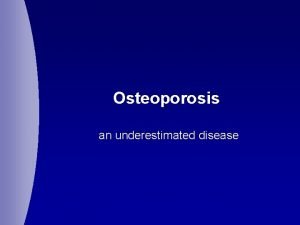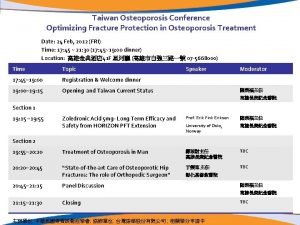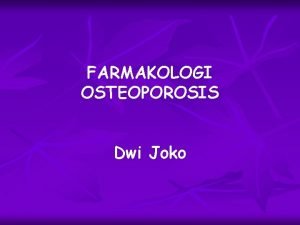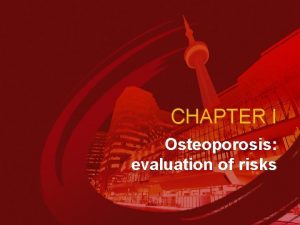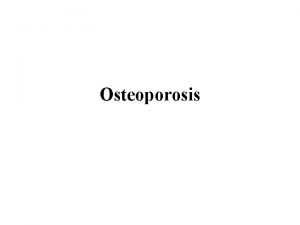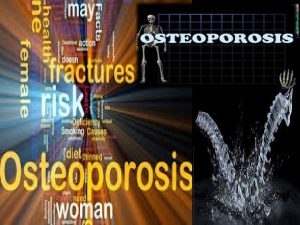Assessment of Osteoporosis Knowledge and Risk of Sedentary






















- Slides: 22

Assessment of Osteoporosis Knowledge and Risk of Sedentary Female Bank Employees Nurcan YABANCI AYHAN, Nida TOKAC ER, ER Haci Omer YILMAZ, Cagdas Salih MERİC, Cahit ERKUL Ankara University, Nutrition and Dietetics Department ntokac@ankara. edu. tr



Osteoporosis is a disease characterized by decreased bone density and loss of bone micro architecture quality which in turn lead to an increased risk of fracture (WHO, 2003).

Magnitude of the Problem It was also reported as the fourth main enemy of the human after heart failure, stroke and cancer, and the most common cause of fractures in the world (WHO, 2003).

10 -year probability of a major osteoporotic fracture risk map (65 -year-old person)

adad Changes Life style Diet habits awareness about the disease can helps in prevention

The present study aimed to determine osteoporosis (OP) knowledge, health believes among a sample of women working in different branch banks in Ankara, Turkey.

Methods Study design Face-to-face survey Includes: ü Demographic and socioeconomic information ü Anthropometric measurements: height, weight

Study population Women employees in banks Ankara, Turkey 200 women employees in banks Voluntary participation (n=156)

The eligibility recruitment to participate in this study Turkish Aged Not 21 -54 years pregnant

Osteoporosis Knowledge Assessment Test (OKAT) Developed by Winzenberg et al (2003) 20 -item question with statements that can answered with true, false, I don't know The instrument consisting of 4 subscales addressing: 1. Understanding (symptoms and risk of fracture) 5 items. 2. Knowledge risk factors of osteoporosis 7 items. 3. Knowledge of prevention factors as physical activity and diet relating to osteoporosis 6 items. 4. Treatment availability 2 items.

One-Minute Osteoporosis Risk Test (ORT) Developed by International Osteoporosis Foundation (IOF) The test includes 19 questions (10 general + 2 for only women/1 for only men + 5 life style) The answer “yes” was awarded 1 points and 0 point “no”

Results

Table 1: Demographics characteristic of subjects (n=156) Variable No (%) Age in years (mean±s. d) 38. 3± 8. 8 Education Secondary and lower 52(33. 3%) University and higher 104 (66. 7%) Marital Status Single 65 (58. 4%) Married 91 (41. 6%)

Table 2: Anthropometric indicators (n=156) Variable No (%) BMI (kg/m²) (Mean±s. d) 23. 6+5. 3 < 18. 5 3 (1. 9%) 18. 5 - 24. 9 87 (55. 8%) 25 – 29. 9 45 (28. 8%) >30. 0 21 (13. 5%)

Table 3: Mean OKAT and ORT scores compared with age Age (years) 20 -29 OKAT Scores (Mean±s. d) 11. 7± 3. 1 ORT Scores (Mean±s. d) 1. 5± 1. 4 30 -39 10. 6± 3. 3 2. 6± 2. 2 40 -49 11. 8± 3. 1 4. 8± 3. 0 50 -59 12. 1± 2. 6 5. 6± 2. 4 p<0. 14 p< 0. 01

Table 4: Mean OKAT and ORT scores compared with BMI (kg/m²) OKAT Scores (Mean±s. d) 9. 3± 1. 1 ORT Scores (Mean±s. d) 1. 6± 0. 5 18. 5 - 24. 9 11. 1± 3. 1 2. 8± 2. 4 25 – 29. 9 12. 4± 2. 9 3. 6± 2. 8 11± 3. 3 5. 5± 3. 4 p< 0. 08 p< 0. 01 < 18. 5 >30. 0

Conclusion The more women’s age and body mass index, the more risk of OP (p < 0. 01). The status of education is related to OP risk. Women graduating from high school had more risk compared to upper level educated women (p < 0. 05).

Reveals lack of knowledge about osteoporosis prevention. The majority of women seemed to be unaware of the potential threat of OP, (esp. younger women), to cease progression of OP or carry a step further any preventative interventions.

KEMİKLERİNİZİ SEVİN

'Peace at Home, Peace in the World. ' Mustafa Kemal ATATÜRK
 Nomadic warrior theory
Nomadic warrior theory Sedentary suspension feeders
Sedentary suspension feeders Hong kong dietary guidelines
Hong kong dietary guidelines Silk glove sign
Silk glove sign Market risk assessment
Market risk assessment Pes statement for osteoporosis
Pes statement for osteoporosis Dual energy x ray absorptiometry (dexa)
Dual energy x ray absorptiometry (dexa) Is osteoporosis hypokinetic or hyperkinetic
Is osteoporosis hypokinetic or hyperkinetic Defination of osteoporosis
Defination of osteoporosis Subjective data for osteoporosis
Subjective data for osteoporosis Woc osteoporosis
Woc osteoporosis Additive and destructive pathology
Additive and destructive pathology Royal osteoporosis society leaflets
Royal osteoporosis society leaflets Osteoporosis
Osteoporosis Osteoporosis
Osteoporosis Defination of osteoporosis
Defination of osteoporosis Tbs osteoporosis
Tbs osteoporosis Defination of osteoporosis
Defination of osteoporosis International osteoporosis foundation
International osteoporosis foundation Whole muscle
Whole muscle Knowledge creation and knowledge architecture
Knowledge creation and knowledge architecture Residual risk and secondary risk pmp
Residual risk and secondary risk pmp Business risk vs financial risk capital structure
Business risk vs financial risk capital structure
